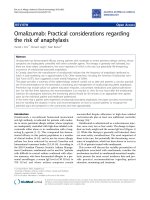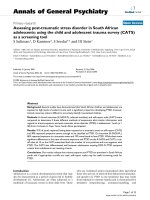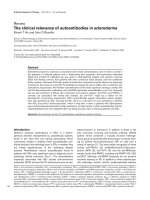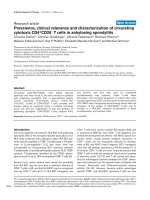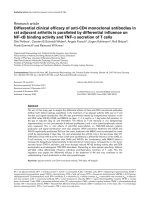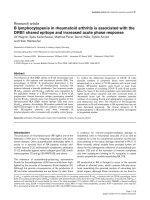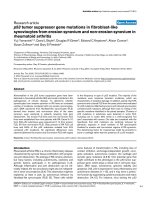Báo cáo y học: "Several clinical interests regarding lung volume reduction surgery for severe emphysema: meta-analysis and systematic review of randomized controlled trials." docx
Bạn đang xem bản rút gọn của tài liệu. Xem và tải ngay bản đầy đủ của tài liệu tại đây (681.53 KB, 26 trang )
This Provisional PDF corresponds to the article as it appeared upon acceptance. Fully formatted
PDF and full text (HTML) versions will be made available soon.
Several clinical interests regarding lung volume reduction surgery for severe
emphysema: meta-analysis and systematic review of randomized controlled
trials
Journal of Cardiothoracic Surgery 2011, 6:148 doi:10.1186/1749-8090-6-148
Wei Huang ()
Wen R Wang ()
Bo Deng ()
You Q Tan ()
Guang Y Jiang ()
Hai J Zhou ()
Yong He ()
ISSN 1749-8090
Article type Research article
Submission date 23 August 2011
Acceptance date 10 November 2011
Publication date 10 November 2011
Article URL />This peer-reviewed article was published immediately upon acceptance. It can be downloaded,
printed and distributed freely for any purposes (see copyright notice below).
Articles in Journal of Cardiothoracic Surgery are listed in PubMed and archived at PubMed Central.
For information about publishing your research in Journal of Cardiothoracic Surgery or any BioMed
Central journal, go to
/>For information about other BioMed Central publications go to
/>Journal of Cardiothoracic
Surgery
© 2011 Huang et al. ; licensee BioMed Central Ltd.
This is an open access article distributed under the terms of the Creative Commons Attribution License ( />which permits unrestricted use, distribution, and reproduction in any medium, provided the original work is properly cited.
Several clinical interests regarding lung volume reduction
surgery for severe emphysema: meta-analysis and
systematic review of randomized controlled trials
1
Wei Huang,
1
Wen R Wang,
1
Bo Deng,
1
You Q Tan,
1
Guang Y Jiang,
1
Hai Jing Zhou and
1
Yong He
1
Thoracic Surgery Department, Institute of Surgery Research, Daping
Hospital, Third Military Medical University, Chongqing, P.R. China
Correspondence: Dr. Bo Deng , Thoracic Surgery Department, Institute
of Surgery Research, Daping Hospital, Third Military Medical
University, Changjiang Branch St, 10#, Yuzhong District, Chongqing
City, 400042, P.R. China.
E-mail:
The authors wish it to be known publicly that the first two authors (Wei
Huang and Ru-Wen Wang) should be regarded as joint first authors.
Abstract
Objectives: We aim to address several clinical interests regarding lung
volume reduction surgery (LVRS) for severe emphysema using
meta-analysis and systematic review of randomized controlled trials
(RCTs).
M
ethods: Eight RCTs published from 1999 to 2010 were identified and
synthesized to compare the efficacy and safety of LVRS vs conservative
medical therapy. One RCT was obtained regarding comparison of
median sternotomy (MS) and video-assisted thoracoscopic surgery
(VATS). And three RCTs were available evaluating clinical efficacy of
using bovine pericardium for buttressing, autologous fibrin sealant and
BioGlue, respectively.
Results: Odds ratio (95%CI), expressed as the mortality of group A (the
group underwent LVRS) versus group B (conservative medical
therapies), was 5.16(2.84, 9.35) in 3 months, 3(0.94, 9.57) in 6 months,
1.05(0.82, 1.33) in 12 months, respectively. On the 3
rd
, 6
th
and 12
th
month, all lung function indices of group A were improved more
significantly as compared with group B. PaO2 and PaCO2 on the 6
th
and
12
th
month showed the same trend. 6MWD of group A on the 6
th
month
and 12
th
month were improved significantly than of group B, despite no
difference on the 3
rd
month. Quality of life (QOL) of group A was better
than of group B in 6 and 12 months. VATS is preferred to MS, due to the
earlier recovery and lower cost. And autologous fibrin sealant and
BioGlue seems to be the efficacious methods to reduce air leak
following LVRS.
Conclusions: LVRS offers the more benefits regarding survival, lung
function, gas exchange, exercise capacity and QOL, despite the higher
mortality in initial three postoperative months. LVRS, with the
optimization of surgical approach and material for reinforcement of the
staple lines, should be recommended to patients suffering from severe
heterogeneous emphysema.
Keywords: LVRS, emphysema, meta-analysis, systematic review
Introduction
Emphysema is a chronic and progressive disease, characterized by
permanent impairment of pulmonary terminal airway, hyperinflation of
parenchyma and loss of elastic retraction. The shortness of breath, poor
exercise tolerance and impaired health status will occur on the final
stage of emphysema [1-3]. Thus far, the conservative medical therapies
(antibiotics, bronchodilators, systemic corticosteroids, home oxygen
therapy, pulmonary rehabilitation) still remain to be symptomatic
treatment rather than always due to failure to improve elastic recoil of
lung issue [2-5]. Lung volume reduction surgery(LVRS), which was
initially introduced in 1957 by Brantigan [6] and developed by Cooper
in 1993[7], resects diseased and non-function pulmonary issue in order
to ameliorate lung function, exercise capacity and health status, by(1)
increasing pulmonary elastic recoil, therefore increasing expiratory
airflow rates, (2) reducing the degree of hyperinflation, therefore
improving mechanics of diaphragm and chest wall, (3) reducing
heterogeneity, (4)increasing work of breathing, and improving of
alveolar gas exchange [8].
Although numerous studies have addressed the patients with severe
emphysema can receive benefits from LVRS, some physicians remain
routinely reluctant to recommend LVRS to the suitable patients due to
the insufficient published Randomized Clinical Trials (RCTs) evaluating
surgical risks and long term sequels [9-12]. Besides, there are
controversial points regarding the efficacy and safety of two approaches
for LVRS [median sternotomy(MS) vs video-assisted thoracoscopy
surgery (VATS)][13]. In addition, various materials have been utilized to
prevent air leak which is one of the most crucial risk factors for LVRS
[14-15], but the efficacy should be assessed immediately. Herein, we
performed a meta-analysis of RCTs published in the past 11 years for the
sake of evaluating safety, short-term efficacy and long-term sequel of
LVRS. And we conduct the systematic review of two approaches (MS vs
VATS) and the materials (bovine pericardium for buttressing, autologous
fibrin sealant and BioGlue) for LVRS.
Materials and methods
We used systematic methods to identify relevant studies, assess study
eligibility, evaluate methodological quality, and summarize findings
regarding postoperative clinical outcomes.
Data sources and searches
Medline and manual searches were performed by two investigators
independently and in duplicate to identify all published RCTs during
from 1999 year to 2010 year that addressed the issue of LVRS for
emphysema.
The Medline search was done on Pubmed
(), one set was created using the medical
subject headings (MeSH) term ‘pneumonectomy’(18249
citations ,March 31
st
,2011) and another was created using the MeSH
term ‘pulmonary emphysema’(12953 citations, March
31
st
,2011).combining the two sets with the Boolean ‘and’ function
yielded 1006 citations, This set was limited by the publication type
‘randomized controlled trial’ to give 36 citations in English. Manual
searches were then done by reviewing articles cited in the reference lists
of identified RCTs, and also by reviewing first author’s article.
Eight published RCTs [2, 12, 16-21] were identified regarding
LVRS vs conservative medical therapies (table 1). Among the eight
RCTs, Pompeo’s article [17] and Mineo’s article[20] were from the
same trial. Pompeo’s study [17] presented mortality, but “mean±SD” of
lung function was missing, wheraes it was presented in Mineo’s study.
T
herefore, we included both of the aforesaid articles. We did not
include unpublished data because of the limited number of RCTs, trials
were not excluded because of trial quality (design) or insufficient
number of patients. A trial quality score was assigned (scale of 1-5)
according to the method of Jadad et al [22]. One investigator screened
the articles and identified article abstracts for full review.
One RCT [13] regarding comparison of two approaches for LVRS
(MS vs VATS) was obtained. And three RCTs [14-15, 23] were available
evaluating clinical efficacy of using bovine pericardium for buttressing,
autologous fibrin sealant and BioGlue, respectively.
Data abstraction
Two investigators abstracted the following information from the
eligible articles without blinding: author, location of study site, journal,
year of publication, study design, number of patients, demographic
characteristics, clinical outcomes, and follow-up period. In all of the
included articles, patients underwent LVRS. Major clinical outcomes for
quantitative data synthesis included postoperative mortality, lung function,
gas exchange (PaO2 and PaCO2), DLCO, 6MWD. Disagreements were
resolved by consensus review with a third investigator.
Statistical analysis
Test- and study-specific estimates
Major postoperative outcomes are defined in the index tests as
follows:(1) Postoperative mortality in the 3, 6 and 12 months.(2)
Postoperative Lung function on the 3
rd
,6
th
and 12
th
month including
FEV1, FEV1%,RV% and TLC%.(3) gas exchange and DLCO% on the
6
th
and 12
th
month.(4) Postoperative 6MWD on the 3
rd
,6
th
and 12
th
month.(5) QOL: We performed systematic review, instead of
meta-analysis of QOL in the RCTs due to the different evaluating
criterion including the Sickness Impact Profile (SIP) scoring system [16],
the 36-item short-Form Health-Related
Questionnaire(SF-36)[2,12,20-21], the Nottingham Health Profile (NHP)
[20], the St George's Respiratory Questionnaire (SGRQ)[2, 20] , Quality
of Well-being scale [18] and the Chronic Respiratory Questionnaire
(CRQ) [19, 21].
Meta-analysis model
A fixed-effect model was applied when the P values of test for
heterogeneity is more than 0.5. A random-effects model was used as it
provided conservative confidence intervals for postoperative outcomes
between study variability (P<0.05). Odds ratio or weighted mean
difference was the principal measure of effect. They were presented as a
point estimate with 95% confidence intervals and P values in
parentheses. Review Manager 4.2.2 (The Cochrane Collaboration.
Wintertree Software inc, Canada) statistical software was used.
Publication bias could not be properly assessed because there were
insufficient RCTs to construct a funnel plot.
Results
The two trial assessors agreed upon the identified and selected RCTs.
RCTs quality scores range from 3 to 5(5-point scale). Trial assessor
agreement on quality assessment was strong (100%). Odds ratio (95%
CI) for mortality, weighted mean difference for lung function
(FEV1,FEV1%,RV%,TLC%),gas exchange(PaO2,PaCO2), DLCO%
and 6MWD were depicted in Figs 1A-E and Table 2.
Meta-analysis of mortality of the group underwent LVRS (group A,
similar thereinafter) and the group received conservative medical
therapies (group B, similar thereinafter) in 3,6 and 12 months.
Odds ratio (95%CI), expressed as the mortality of group A versus
group B, was 5.16(2.84, 9.35) in 3 months, 3(0.94, 9.57) in 6 months,
1.05(0.82, 1.33) in 12 months, respectively.
Figure 1 A demonstrated that mortality in 3 months was significantly
lower in group B than in group A (test for overall effect, Z=5.4,
P<0.0001), as well as the same trend on mortality in 6 months despite
no statistical significance (Z=1.86, P=0.06) (Figure 1 B). However,
there was no significant difference of mortality between the two groups
in 12 months (Figure 1 C, test for overall effect, Z=0.36, P=0.72).
Additionally, we got the same trend regarding the mortality in either 3 or
12 months (Figure 1D and 1E, Z=2.35, P=0.02; Z=1.58, P=0.11,
respectively) after excluded the results from Fishman’s study which was
an extremely large sample trial and might result in the bias.
Meta-analysis of lung function, gas exchange and DLCO% a
nd 6MWD on the 3
rd
, 6
th
and 12
th
month
We conducted meta-analysis from six RCTs regarding lung function,
gas exchange and DLCO% and 6MWD on the 3
rd
, 6
th
, 12
th
month
(Table2). Two RCTs (Fishman A et al. [18] and Geddes et al[12]) were
not included without expression of “mean ± SD” of aforesaid indices.
On the 3
rd
, 6
th
and 12
th
month, all lung function indices of group A
were improved more significantly compared with group B (Table2).
PaO2 and PaCO2 on the 6
th
and 12
th
month were available in the RCTs,
and either showed the same trend (Table2). 6MWD of group A on the 6
th
month and 12
th
month were improved significantly than of group B
(Table2), although there was no difference on the 3
rd
month.
Systematic review of QOL
The RCTs strongly suggested that QOL of group A was better than of
group B in the 6 and 12 months [2,12,16-21] (Geddes’s study[12]
indicated no difference between the groups in 3 months). Besides,
long-term follow up also supported the aforementioned conclusion
[18,20] (Mineo et al.[20]: 48 months and Fishman A et al. [18]: 24
months).
Comparison of two surgical approaches (MS vs VATS)
Only one RCT [13] regarding comparison of MS and VATS
indicated (1) there was no difference of 90-day or overall mortality
(P=0.67 and 0.42, respectively), (2) mean intra-operative blood loss or
transfusion needs were similar (P=0.99), (3) mean operation time of
MS was shorter 21.7 minutes in comparison with VATS (P<0.001), (4)
intra-operative complications and hypoxemia of MS was less in
comparison with VATS (P=0.02, P=0.004), (5) hospital stay of post
LVRS was longer for MS than VATS (P=0.01), (6) at postoperative 30
days, independently living patients were less for MS than VATS
(P=0.02), (7) there was no appreciable difference in lung function
between the two approaches after follow-up 12 and 24 months, (8)
costs for either operation or the associated hospital stay were less for
VATS than for MS (P<0.01).
Clinical efficacy of using bovine pericardium for buttressing,
autologous fibrin sealant and BioGlue during LVRS
In 2000, a RCT[23] w
as conducted in 65 patients underwent
bilateral lung volume reduction surgery by VATS, either without
(control group) or with bovine pericardium for buttressing. The RCT
demonstrated using bovine pericardium significantly decrease the
median air leak time compared with control group (0.0 day [range, 0
to 28 days versus 4 days [range, 0 to 27 days); p < 0.001), as well as
median drainage time (5 days [range, 1 to 35 days] versus 7.5 days
[range, 2 to 29 days); P=0.045).
In 2008, a RCT [15] was conducted in 25 patients undergoing
bilateral LVRS by VATS. The result indicated that mean value of
t
he total severity scores of air leak for the first 48 hours postoperative
was significant lower in the treated side (with using autologous fibrin
sealant) than in the control side (without using autologous fibrin sealant)
(P<0.01), independently of the length of the resection. Prolonged air
leak and mean duration of drainage were also significantly reduced in
the treated group compared with the control group (4.5% and 2.8±1.9
days versus 31.8% and 5.9±2.9 days, respectively)(P=0.03, P<0.01).
In 2009, a pilot RCT [14] was conducted in ten patients
undergoing LVRS via MS approach. Each case was treated with
BioGlue on one side randomly and pericardial buttress on the
other side as an adjunct to the staple line. The result suggested that
BioGlue treated side had the shorter mean duration of air-leak (3.0±4.6
vs 6.5±6.9 days), lesser chest drainage volume(733±404 vs 1001±861
ml) and shorter time to chest drain removal (9.7±10.6 vs 11.5±11.1
days) compared with pericardial buttress side.
Discussion
World Health Organization suggested that emphysema will
probably become the third cause of death with cigarette smoking [24].
More and more studies are focusing on the treatment of emphysema
which is still untoward. Conservative medical therapies can not provide
satisfactory long term therapeutic efficacy [5]. With regard to LVRS, the
mortality and efficacy is still controversial. Therefore, we deem it
essential to synthesize the published RCTs, evaluate safety, assess
short-term efficacy and long-term sequel of LVRS by systemic review
and meta-analysis.
Meta-analysis suggested that postoperative mortality of LVRS
group gradually decreased from 3 months to 12 months. In the initial
three months, the mortality of LVRS group was significantly higher than
conservative treatment group due to respiratory failure and pulmonary
infection[2,12,16-21]. However, there was no significant difference on
mortality between the two aforesaid groups until the 12 months. NETT
[25] suggested that the high risk factors of LVRS, including FEV1 <20%
of predicted value with either homogeneous emphysema or DLCO%
<20%, lead to higher thirty-day and overall mortality. In addition,
Fishman et al. [18] suggested mortality in three months following LVRS
was lower in the patients suffering from upper-lobe emphysema
combining low exercerise capacity even compared with conservative
treatment group, probably due to clearer target areas or more accessible
areas for surgical excision. Intriguingly, Fishman et al. [18]
demonstrated that overvall mortality of LVRS group (except high risk
patients) was statistically lower than of conservative treatment group
after 5 years follow up.
Meta-analysis also suggested lung function indices of LVRS group
were appreciably improved on the 3
th
, 6
th
and 12
th
postoperative month,
compared with conservative treatment group , in accordance to results of
Fishman’s study[18]. With regard to DLCO %, there was not
appreciablly difference between two groups (P>0.05), consisting with
outcomes of Geddes’s study[12]. However, only two RCTs mentioned
DLCO %, and more data should be accumulated.
The effect of LVRS on PaO2 and PaCO2 was still controversial.
For instance, Geddes’s study[12] demonstrated insignificant improvment
o
f PaO2 and PaCO2 following LVRS. Snyder’s study [26] manifested
that LVRS can increase PaO2 efficaciously (P< 0.001)(PaCO2 not
shown). In addtion, Cremona et al. [27]suggested that LVRS improved
PaO2, without significant effect on PCO2. However, our meta-analysis
demonstrated that LVRS can increase PaO2 and decrease PaCO2
appreciably.
With respect to 6MWD, we concluded that LVRS can obviously
increase exercise capacity on the 6
th
and 12
th
postoperative month, in
accordance to outcomes of Fishman’s [18] and Geddes’s study[12].
Naunheim et al. [28] reported that improvement of post-operative
exercise capacity can be maintained up to 3 years, especially in
upper-lobe emphysema combining low exercise capacity.
Despite the different assessment criterion of the seven included RCTs,
all the studies concluded that LVRS can improve QOL efficaciously.
Krachman et al. [29] found that in patients with sev
ere emphysema,
LVRS, but not continued optimal medical therapy, results in improved
sleep quality and nocturnal oxygenation. Kozora et al. [30] found that
LVRS group demonstrated improvement in specific neuropsychological
functions, depression, anxiety compared with conservative treatment
group due to the unclear mechanisms. Additionally, compared with
medical therapy, LVRS reduces the frequency of COPD exacerbations,
increases the time to first exacerbation, and has a significant effect on the
composite QOL survival endpoint tested [31-32].
The published RCT [13] concluded that morbidity and mortality
were similar following either MS or VATS, as well as pulmonary
function indices. Additionally, another study [33] suggested that two
techniques offered similar outcomes regarding postoperative pain and
complications, but VATS allowed earlier recovery at a lower cost than
MS.
A variety of biologic and synthetic materials have been utilized to
prevent and minimize air leak, including buttressing materials for
instance bovine pericardium, poly-tetrafluoroethylene(PTFE), Teflon,
polyglycollic acid and gel foam[14-15,23]. In patients suffering from
severe emphysema and undergoing LVRS, buttressing of staple lines
with bovine pericardial strips are traditionally and routinely used to
reduce air leaks from rarefied emphysematous lung tissue. However,
its efficacy remains inconclusive. Hazelrigg ’s study[34] suggested
that using buttressing reduced 2 to 3 days of hospital stay. And
Stammberger’s RCT [23] indicated a statistically significant
reduction in air leak duration after bilateral, buttressed,
thoracoscopic LVRS, in spite of no reduction in length of stay.
However, Moser et al. [15] pointed that buttressing adjuncts might
result in the extensive inflammatory reaction with formation of
dense adhesions, which enhances difficulty of lung transplantation
after LVRS. And Moser et al. [15] suggested that autologous fibrin
sealant overcomes the potential infective and antigenic risk in
comparison to using pooled human fibrinogen or exogenous
thrombin, especially of bovine origin. Besides, the results of
Rathinam’s study [14] also prefer BioGlue to conventional
buttresses in terms of reduction in air-leak, chest drainage volumes,
duration of chest drainage and significant absence of complications.
Recently, a new rigid applicator tip (CryoLife Inc, U.S.A), 34 cm in
length, is developed and enables precise delivery in VATS. We
deem BioGlue and autologous fibrin sealant the efficacious methods
to reduce air leak following LVRS.
Currently, a variety of novel, less invasive bronchoscopic lung
volume reductions (BLVR) has proceeded to human trials including
one-way occlusive valves, sclerosant biogels, and endobronchial bypass
tract formation[10, 35]. However, current data available in the small,
nonrandomized studies only showed short-term improvement of
dyspnoea and quality of life post BLRV[10]. Thus, further RCTs are
required regarding the comparison of BVRL and LVRS [36].
Collectively, LVRS offers the more benefits regarding survival,
lung function, gas exchange, exercise capacity and QOL, despite high
postoperative mortality in initial three months. As a result, LVRS should
be duly recommended to patients with severe emphysema and without
high risk factors. With regard to LVRS approaches, we prefer VATS to
MS, due to the earlier recovery and lower cost. And we deem autologous
fibrin sealant and BioGlue an efficacious method to reduce air leak
following LVRS.
Abbreviation: LVRS (Lung volume reduction surgery); RCTs
(randomized controlled trials); VATS (video-assisted thoracoscopic
surgery); MS(median sternotomy); FEV1(forced expiratory volume in
one second); RV (residual volume); TLC (total lung capacity); PaO2
(pressure of arterial partial oxygen); PaCO2 (pressure of arterial CO2);
DLCO (Diffusion capacity of the lung for carbon monoxide); 6MWD
(six-minute walk distance); QOL (Quality of life); FEV1 (forced
expiratory volume in one second); FEV1% (percentage of predicted
values for FEV1),RV% (percentage of predicted values for residual
volume),TLC%(percentage of predicted values for total lung capacity)
Competing interests: The authors have no conflicts of interest that are
directly related to the content of the study.
Authors' contributions: BD and WH carried out to study design and
RCTs assessment. WH, RWW and BD carried out data analysis and
manuscript writing. QYT, YGJ, YGL, JHZ and YH participated in
writing the manuscript. All authors read and approved the final
manuscript.
Acknowledgement: The authors appreciate the statistical review from
Lee in epidemiological department, third military medical university.
And we appreciate Dr. Sridhar Rathinam for his excellent comments
which greatly improved our manuscript.
References:
1. Decramer M. Treatment of chronic respiratory failure: lung volume reduction surgery versus
rehabilitation. Eur Respir J Suppl 2003;47:47s-56s.
2. Hillerdal G, Lofdahl CG, Strom K, Skoogh BE, Jorfeldt L, Nilsson F, et al. Comparison of lung
volume reduction surgery and physical training on health status and physiologic outcomes: a
randomized controlled clinical trial. Chest 2005;128(5):3489-99.
3. Sardenberg RA, Younes RN, Deheizelin D. Lung volume reduction surgery: an overview. Rev Assoc
Med Bras 2010;56(6):719-23.
4. Rationale and design of the National Emphysema Treatment Trial (NETT): A prospective
randomized trial of lung volume reduction surgery. J Thorac Cardiovasc Surg
1999;118(3):518-28.
5. Celli BR, MacNee W. Standards for the diagnosis and treatment of patients with COPD: a summary
of the ATS/ERS position paper. Eur Respir J 2004;23(6):932-46.
6. Brantigan OC. Surgical treatment of pulmonary emphysema. Md State Med J 1957;6(7):409-14.
7. Cooper JD, Trulock EP, Triantafillou AN, Patterson GA, Pohl MS, Deloney PA, et al. Bilateral
pneumectomy (volume reduction) for chronic obstructive pulmonary disease. J Thorac
Cardiovasc Surg 1995;109(1):106-16; discussion 16-9.
8. Yusen RD, Lefrak SS. Evaluation of patients with emphysema for lung volume reduction surgery.
Washington University Emphysema Surgery Group. Semin Thorac Cardiovasc Surg
1996;8(1):83-93.
9. Criner GJ, Mamary AJ. Lung volume reduction surgery and lung volume reduction in advanced
emphysema: who and why? Semin Respir Crit Care Med 2010;31(3):348-64.
10. Criner GJ, Cordova F, Sternberg AL, Martinez FJ. The NETT: Part II- Lessons Learned about Lung
Volume Reduction Surgery. Am J Respir Crit Care Med 2011.
11. Miller JD, Malthaner RA, Goldsmith CH, Goeree R, Higgins D, Cox PG, et al. A randomized
clinical trial of lung volume reduction surgery versus best medical care for patients with
advanced emphysema: a two-year study from Canada. Ann Thorac Surg 2006;81(1):314-20;
discussion 20-1.
12. Geddes D, Davies M, Koyama H, Hansell D, Pastorino U, Pepper J, et al. Effect of
lung-volume-reduction surgery in patients with severe emphysema. N Engl J Med
2000;343(4):239-45.
13. McKenna RJ, Jr., Benditt JO, DeCamp M, Deschamps C, Kaiser L, Lee SM, et al. Safety and
efficacy of median sternotomy versus video-assisted thoracic surgery for lung volume
reduction surgery. J Thorac Cardiovasc Surg 2004;127(5):1350-60.
14. Rathinam S, Naidu BV, Nanjaiah P, Loubani M, Kalkat MS, Rajesh PB. BioGlue and Peri-strips in
lung volume reduction surgery: pilot randomised controlled trial. J Cardiothorac Surg
2009;4:37.
15. Moser C, Opitz I, Zhai W, Rousson V, Russi EW, Weder W, et al. Autologous fibrin sealant reduces
the incidence of prolonged air leak and duration of chest tube drainage after lung volume
reduction surgery: a prospective randomized blinded study. J Thorac Cardiovasc Surg
2008;136(4):843-9.
16. Criner GJ, Cordova FC, Furukawa S, Kuzma AM, Travaline JM, Leyenson V, et al. Prospective
randomized trial comparing bilateral lung volume reduction surgery to pulmonary
rehabilitation in severe chronic obstructive pulmonary disease. Am J Respir Crit Care Med
1999;160(6):2018-27.
17. Pompeo E, Marino M, Nofroni I, Matteucci G, Mineo TC. Reduction pneumoplasty versus
respiratory rehabilitation in severe emphysema: a randomized study. Pulmonary Emphysema
Research Group. Ann Thorac Surg 2000;70(3):948-53; discussion 54.
18. Fishman A, Martinez F, Naunheim K, Piantadosi S, Wise R, Ries A, et al. A randomized trial
comparing lung-volume-reduction surgery with medical therapy for severe emphysema. N
Engl J Med 2003;348(21):2059-73.
19. Goldstein RS, Todd TR, Guyatt G, Keshavjee S, Dolmage TE, van Rooy S, et al. Influence of lung
volume reduction surgery (LVRS) on health related quality of life in patients with chronic
obstructive pulmonary disease. Thorax 2003;58(5):405-10.
20. Mineo TC, Ambrogi V, Pompeo E, Elia S, Mineo D, Bollero P, et al. Impact of lung volume
reduction surgery versus rehabilitation on quality of life. Eur Respir J 2004;23(2):275-80.
21. Miller JD, Berger RL, Malthaner RA, Celli BR, Goldsmith CH, Ingenito EP, et al. Lung volume
reduction surgery vs medical treatment: for patients with advanced emphysema. Chest
2005;127(4):1166-77.
22. Jadad AR, Moore RA, Carroll D, Jenkinson C, Reynolds DJ, Gavaghan DJ, et al. Assessing the
quality of reports of randomized clinical trials: is blinding necessary? Control Clin Trials
1996;17(1):1-12.
23. Stammberger U, Klepetko W, Stamatis G, Hamacher J, Schmid RA, Wisser W, et al. Buttressing the
staple line in lung volume reduction surgery: a randomized three-center study. Ann Thorac
Surg 2000;70(6):1820-5.
24. Morissette MC, Parent J, Milot J. Alveolar epithelial and endothelial cell apoptosis in emphysema:
what we know and what we need to know. Int J Chron Obstruct Pulmon Dis 2009;4:19-31.
25. NETT.Patients at high risk of death after lung-volume-reduction surgery. N Engl J Med
2001;345(15):1075-83.
26. Snyder ML, Goss CH, Neradilek B, Polissar NL, Mosenifar Z, Wise RA, et al. Changes in arterial
oxygenation and self-reported oxygen use after lung volume reduction surgery. Am J Respir
Crit Care Med 2008;178(4):339-45.
27. Cremona G, Barbara JA, Melgosa T, Appendini L, Roca J, Casadio C, et al. Mechanisms of gas
exchange response to lung volume reduction surgery in severe emphysema. J Appl Physiol
2011;110(4):1036-45.
28. Naunheim KS, Wood DE, Mohsenifar Z, Sternberg AL, Criner GJ, DeCamp MM, et al. Long-term
follow-up of patients receiving lung-volume-reduction surgery versus medical therapy for
severe emphysema by the National Emphysema Treatment Trial Research Group. Ann Thorac
Surg 2006;82(2):431-43.
29. Krachman SL, Chatila W, Martin UJ, Nugent T, Crocetti J, Gaughan J, et al. Effects of lung volume
reduction surgery on sleep quality and nocturnal gas exchange in patients with severe
emphysema. Chest 2005;128(5):3221-8.
30. Kozora E, Emery CF, Ellison MC, Wamboldt FS, Diaz PT, Make B. Improved neurobehavioral
functioning in emphysema patients following lung volume reduction surgery compared with
medical therapy. Chest 2005;128(4):2653-63.
31. Washko GR, Fan VS, Ramsey SD, Mohsenifar Z, Martinez F, Make BJ, et al. The effect of lung
volume reduction surgery on chronic obstructive pulmonary disease exacerbations. Am J
Respir Crit Care Med 2008;177(2):164-9.
32. Benzo R, Farrell MH, Chang CC, Martinez FJ, Kaplan R, Reilly J, et al. Integrating health status
and survival data: the palliative effect of lung volume reduction surgery. Am J Respir Crit
Care Med 2009;180(3):239-46.
33. Boley TM, Reid A, Manning BT, Markwell SJ, Vassileva CM, Hazelrigg SR. Sternotomy or
bilateral thoracoscopy: pain and postoperative complications after lung-volume reduction
surgery. Eur J Cardiothorac Surg 2011.
34. Hazelrigg SR, Boley TM, Naunheim KS, Magee MJ, Lawyer C, Henkle JQ, et al. Effect of bovine
pericardial strips on air leak after stapled pulmonary resection. Ann Thorac Surg
1997;63(6):1573-5.
35. Ernst A, Anantham D. Bronchoscopic lung volume reduction. Pulm Med 2011;2011:610802.
36. Seijo L. Endoscopic interventions in severe emphysema. Am J Respir Crit Care Med
2009;180(7):684; author reply 84.
Figure legend:
Figure 1 Meta-analysis of mortality of group A and group B in 3,6
and 12 months. A: mortality in 3 months (including Fishman’s study); B:
mortality in 6 months; C: mortality in 12 months(including Fishman’s
study); D mortality in 3 months (excluding Fishman’s study); E mortality
in 12 months (excluding Fishman’s study).
Table 1.Summary of RCTs on conservative medical therapy and LVRS.
*: V/Q scan, also known as lung scan, which evaluates both the
Ventilation and Perfusion of the lungs using scintigraphy and medical
isotopes. Q is the symbol for perfusion which represents the movement of
blood through the arteries that supply the lung.
Author Year
published
Cases
(N)
Imaging
diagnosis
Cases
underwent
conservative
medical
therapy (n)
Cases
underwent
LVRS(n)
Criner, G.
J[16]
1999
37 CT scan 18 19
Geddes, D[12]
2000 48 CT scan 24 24
Pompeo,E.[17]
2000 60 CT scan 30 30
Fishman, A
[18]
2003 1218 CT scan 608 610
Goldstein, R.
S [19]
2003 55 CT and V/Q
scan*
28 27
Mineo[20]
2004 60 CT scan 30 30
Hillerdal,
G.[2]
2005 106 CT and V/Q
Scan*
53 53
Miller, J.
D[21]
2005 93 CT and V/Q
Scan*
58 35
Table 2.A summary of lung function, gas exchange, DLCO% and 6MWD of five RCTs on the 3
rd
, 6
th
, 12
th
postoperative
month.
Variables
Postoperative
follow-up
(month)
No of RCTs No of
total
patients
GroupA/B
WMD95%CI p-value
3 2[12, 16] 80
39/41 0.23(0.08,0.37) 0.002
6 3[2,17,19] 180 89/91 0.32(0.23,0.41) <0.00001
FEV1
12 3[2, 17, 19] 169 65/64 0.28(0.20,0.36) <0.00001
3 2[12, 16] 80 39/41 11.31(6.29,15.69) <0.00001
6 3[2,17,19] 180 89/91 10.16(7.42,12.89) <0.00001
FEV1%
12 3[2,17,19] 167
85/82 7.65(4.97,10.33) <0.00001
3
2[12,16]
80
39/41
-54.44(-75.23,
-33.85)
<0.00001
6
3[2,17,19]
170
87/83
- 54.09( -
64.66,
-43.52)
<0.00001
RV%
12
3[2,17,19] 166 86/80 - 53.42( -
63.74,
-43.10)
<0.00001
3
2[12,16]
80
39/41
- 21.70( -
30.98,
-12.42)
<0.00001
TLC%
6
2[2,19]
115
59/56
- 15.73( -
22.44,
-9.02)
<0.00001
12
3[2,17,19] 120 59/61 - 16.24( -
23.07,
-9.41)
<0.00001
6 2[17,19] 105 52/53 0.01(-0.25,0.27) 0.95
DLCO%
12 2[17, 19] 96 51/45 0.01(-0.25,0.27) 0.25
6 2[17,19] 136 67/6 9.98(9.65,10.13) <0.00001
Pa02
12 2[2,17] 114
60/54 6.37(6.10,6.64) <0.00001
6
4[2,11,17,21]
229
108/121
- 1.54( - 1.72, -
1.36)
<0.00001
PaCO2
12 2[2,17] 114 60/54
- 2.00( - 2.23, -
1.77)
<0.00001
3 2[12,16] 80 39/41 10.5(-16.30,37.38)
0.44
6MWD
6 5[2,11,17,19 ,21]
274 129/145 68.34(36.58,100.09)
<0.00001
12 3[2,17,19] 168 85/83 76.92(60.87,92.98) <0.00001
Figure 1


